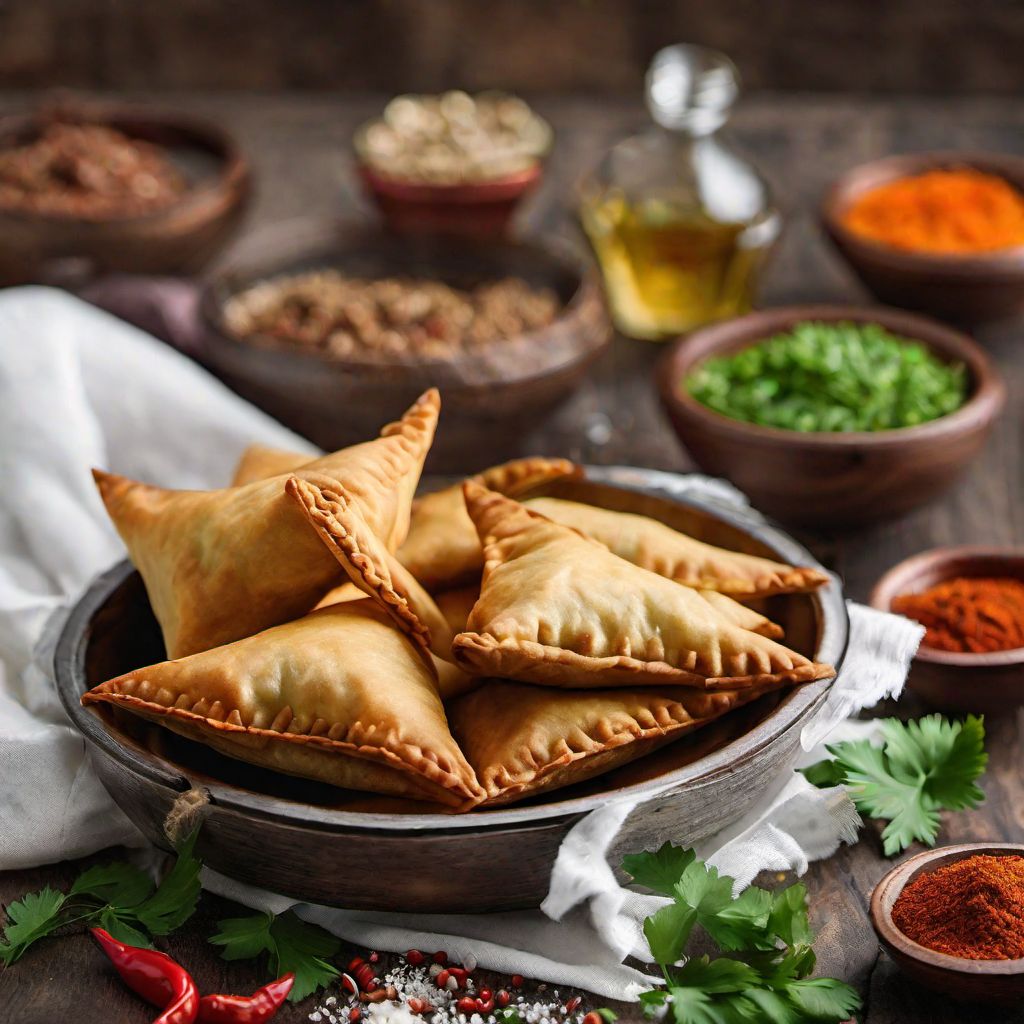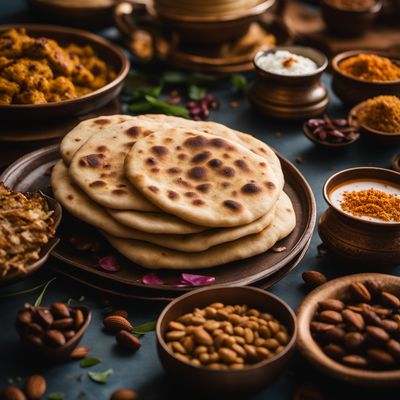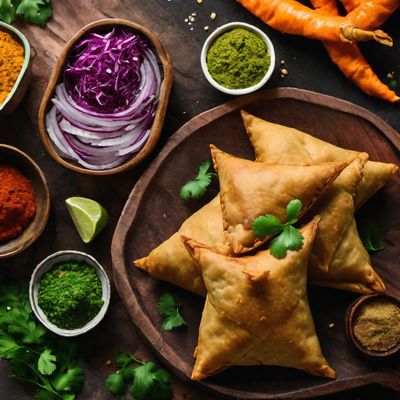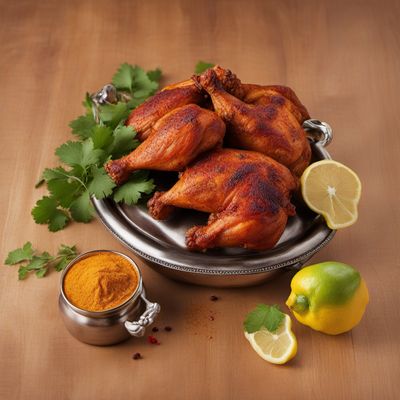
Recipe
Turkish-style Samosa
Turkish Delight Samosa: A Fusion of Flavors
4.8 out of 5
In Turkish cuisine, the samosa takes on a delightful twist, combining the traditional Indian flavors with a touch of Turkish influence. This Turkish-style samosa is a mouthwatering treat that will transport you to the vibrant streets of Istanbul. With its crispy pastry and flavorful filling, it's a perfect appetizer or snack for any occasion.
Metadata
Preparation time
30 minutes
Cooking time
20 minutes
Total time
50 minutes
Yields
4 servings
Preparation difficulty
Medium
Suitable for
Halal, Gluten-free (if using gluten-free filo pastry), Dairy-free (if using dairy-free margarine instead of butter), Nut-free, Low-carb (if using a low-carb alternative for the pastry)
Allergens
Wheat (if using regular filo pastry), Dairy (if using butter)
Not suitable for
Vegan, Vegetarian, Paleo, Keto, High-fiber
Ingredients
While the Indian samosa is typically filled with spiced potatoes and peas, the Turkish-style samosa incorporates a variety of ingredients such as minced lamb or beef, onions, garlic, and a blend of aromatic Turkish spices. The pastry is also slightly different, with a lighter and flakier texture, making it a unique and delicious variation of the classic samosa. We alse have the original recipe for Samosa, so you can check it out.
-
250g (9 oz) minced lamb or beef 250g (9 oz) minced lamb or beef
-
1 onion, finely chopped 1 onion, finely chopped
-
2 cloves of garlic, minced 2 cloves of garlic, minced
-
1 teaspoon ground cumin 1 teaspoon ground cumin
-
1 teaspoon ground coriander 1 teaspoon ground coriander
-
1/2 teaspoon paprika 1/2 teaspoon paprika
-
1/4 teaspoon ground cinnamon 1/4 teaspoon ground cinnamon
-
Salt and pepper to taste Salt and pepper to taste
-
12 sheets of filo pastry 12 sheets of filo pastry
-
100g (3.5 oz) butter, melted 100g (3.5 oz) butter, melted
-
Vegetable oil for frying Vegetable oil for frying
Nutrition
- Calories (kcal / KJ): 350 kcal / 1465 KJ
- Fat: 20g (total), 10g (saturated)
- Carbohydrates: 25g (total), 2g (sugars)
- Protein: 18g
- Fiber: 2g
- Salt: 0.8g
Preparation
-
1.In a large pan, heat a tablespoon of vegetable oil over medium heat. Add the minced lamb or beef and cook until browned. Remove from the pan and set aside.
-
2.In the same pan, add another tablespoon of oil and sauté the chopped onion until translucent. Add the minced garlic and cook for another minute.
-
3.Return the cooked meat to the pan with the onions and garlic. Add the ground cumin, ground coriander, paprika, ground cinnamon, salt, and pepper. Stir well to combine and cook for a few minutes until the flavors meld together. Remove from heat and let the filling cool.
-
4.Preheat the oven to 180°C (350°F).
-
5.Lay one sheet of filo pastry on a clean surface and brush it lightly with melted butter. Place another sheet on top and repeat the process until you have a stack of 6 sheets.
-
6.Cut the stacked filo pastry into 3 equal strips lengthwise.
-
7.Take one strip and place a spoonful of the meat filling at the bottom corner. Fold the pastry diagonally to form a triangle, enclosing the filling. Continue folding the triangle until you reach the end of the strip. Repeat with the remaining strips and filling.
-
8.Heat vegetable oil in a deep pan or fryer. Fry the samosas in batches until golden brown and crispy. Remove from the oil and drain on a paper towel.
-
9.Place the fried samosas on a baking sheet and bake in the preheated oven for 10-15 minutes to ensure they are fully cooked and heated through.
-
10.Serve the Turkish-style samosas hot with a side of yogurt or a tangy dipping sauce.
Treat your ingredients with care...
- Filo pastry — Keep the filo pastry sheets covered with a damp cloth while working to prevent them from drying out.
- Minced lamb or beef — Make sure to cook the meat thoroughly before adding the spices to ensure a flavorful and well-cooked filling.
- Turkish spices — Adjust the amount of spices according to your taste preferences. You can also add a pinch of chili flakes for a spicy kick.
- Butter — If you prefer a lighter option, you can use olive oil instead of butter for brushing the filo pastry.
Tips & Tricks
- To make the samosas extra crispy, brush them with melted butter before baking.
- Serve the samosas immediately after baking to enjoy them at their best.
- You can freeze the uncooked samosas for later use. Just place them on a baking sheet lined with parchment paper, freeze until firm, and then transfer to a freezer bag. When ready to cook, fry them directly from frozen, adding a few extra minutes to the cooking time.
- Experiment with different fillings such as spinach and feta cheese or roasted vegetables for a vegetarian option.
- If you don't have filo pastry, you can use spring roll wrappers as a substitute.
Serving advice
Serve the Turkish-style samosas as an appetizer or snack. They pair well with a refreshing yogurt dip or a tangy tamarind chutney. Garnish with fresh herbs like parsley or mint for an extra burst of flavor.
Presentation advice
Arrange the samosas on a platter, garnished with fresh herbs and a sprinkle of paprika for a pop of color. Serve them alongside the dipping sauce in small bowls or ramekins for an elegant presentation.
More recipes...
For Samosa » Browse all
For Indian cuisine » Browse all
More Indian cuisine dishes » Browse all

Misal
Misal is a spicy Maharashtrian dish made with sprouted beans, spices, and a fiery gravy. It is typically served with bread or rice.

Missi roti
Missi roti is a traditional Indian flatbread that is usually made with chickpea flour. It is a popular bread in the northern regions of India and...

Peshwari naan
Peshwari naan is a sweet and nutty Indian bread that is typically stuffed with a mixture of coconut, raisins, and almonds. It is a popular...











